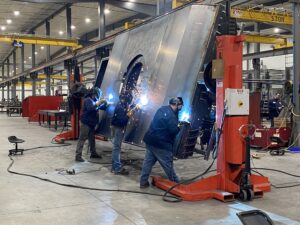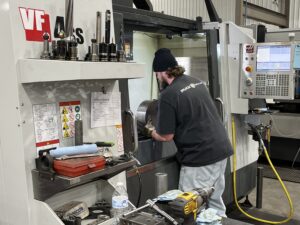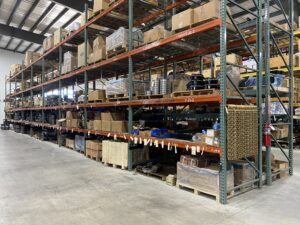
As Puck Custom Enterprises, a Manning-based manufacturer of liquid transfer equipment, continues to grow, they need to ensure their business practices continue to meet their needs. Recently, this meant upgrading their quality systems and their approaches to managing their supply chain.
“We are always striving to produce a higher quality product, and after being in manufacturing for almost 45 years, we felt it was time to implement ISO 9001 to be able to move up to those standards,” said Laura Pepple, Puck’s director of business development. “We’ve partnered with CIRAS on a variety of projects with positive outcomes, so utilizing them as a resource for this project was immediately part of our thought process.”
In June 2022, Puck started working with CIRAS and a third-party advisor to implement an ISO 9001 management system.
“Doing this on your own takes a lot of time and people power. We have fully vetted personnel who have a strong track history for being professional and knowledgeable about the standards,” said Ben Drescher, CIRAS project manager. “They are focused on getting the quality system up to speed and making sure as a company you are still producing your products and making money.”

There is a large learning curve when entering the world of ISO 9001 quality standards and a significant amount of record reviewing and paperwork.
“When you read the standards, they are written with a very broad brush and sometimes are open to interpretation. Being able to utilize CIRAS expertise to further break down how a standard applies directly to our processes was extremely beneficial,” said Pepple. “The number one takeaway from working with CIRAS was their ability to explain ‘the why’ behind the question and then present multiple avenues of approach to accomplish the task or procedure.”
“An ISO 9001 audit looks at the entire manufacturing system and quality processes, from how products are designed to how employees are trained on quality post checks and how committed management is to a quality system,” said Drescher. “It is a world-recognized standard for how manufacturing is done. Puck is a rapidly expanding company, and obtaining ISO certification will help them attract new business.”
Puck achieved ISO 9001 certification in April 2023.
“It was a huge relief, especially when we were able to pass without any major findings,” said Pepple.
ISO 9001 companies are required to conduct surveillance audits annually. These are typically internal audits to ensure the company is still meeting ISO standards. “We did our surveillance audit in April 2024 and once again turned to CIRAS. They worked well with our team during the entire certification process, and they were intimate with our company and our processes. That’s what we needed—someone familiar with us but who could also bring fresh eyes that would find any gaps,” said Pepple.
“As we continue to diversify and seek new markets, having ISO 9001 certification will help tremendously,” said Pepple.
The ISO 9001 certification also has a supplier scorecard, which dovetailed nicely with a supply chain mapping project Puck partnered on with CIRAS.
“This is a deep dive into a company’s complex supply chain. It gives clients better visibility of their inbound supply chain. It identifies risks and opportunities to mitigate them,” said Marc Schneider, CIRAS supply chain project manager.

“We were seeking to identify high-risk suppliers, as well as high-risk freight gateways, and we wanted to understand how to perform a risk assessment on suppliers utilizing this type of analysis for our purchasing program,” said Pepple. “Our supplies come from all over the world.”
CIRAS supply chain mapping is designed to provide a company with a comprehensive view of their supply chain, including who is providing materials, geographic concentrations, where main suppliers get their supplies, and how shipments are routed. Each supplier is given a risk index score, a picture of the costs, and then interdependencies related to suppliers emerge.
“We help companies know where to focus their efforts and geographically display that with heat maps, taking into account weather risk areas and other factors,” Schneider said. “Using this information, we can help a company develop risk mitigation plans for top suppliers. All this makes supply chains more resilient and reliable for companies and their customers.”
The process also helps identify opportunities for a company to leverage its supply chain to build stronger relationships with suppliers, enhance efficiency, and reduce costs.
“One of the key outcomes of the Puck mapping project was being able to assess the risk related to our suppliers across multiple criteria, including reliability, on-time delivery, and critical need of that component,” said Pepple.
“With this analysis, we are now able to make better strategic decisions to reduce the overall risk exposure to our supply chain, whether that be sourcing alternate suppliers or eliminating hardto-source components,” said Pepple. “We are also able to approach high-risk suppliers and be very transparent about the outcome of the ISO scorecard and CIRAS risk assessment. With this data, we were able to approach one of our highest-risk suppliers and challenge them to do better. We’ve had great success with them since that conversation. This is ultimately the goal: better service from suppliers and higher quality products for our customers.”
For more information on ISO certification support, contact Ben Drescher at bdresche@iastate.edu or 515-509-0940. For information about supply chain risk mapping, contact Marc Schneider at maschn@iastate.edu or 563-221-1596